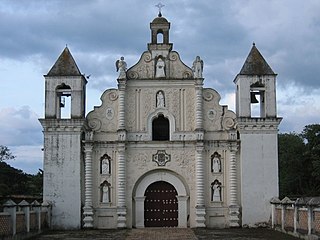
Copán is one of the departments in the western part of Honduras. The departmental capital is the town of Santa Rosa de Copán. The department is well known for its tobacco and fine cigars.

Lempira is one of the 18 departments in Honduras. located in the western part of the country, it is bordered by the departments of Ocotepeque and Copán to the west, Intibucá to the east, and Santa Bárbara to the north. To its south lies the El Salvador–Honduras border. The departmental capital is Gracias.

Santa Rosa de Copán is a municipality in Honduras. The city of Santa Rosa de Copán is the municipal seat and the departmental capital of the Honduran department of Copán. It is located approximately 1,150 metres (3,773 ft) above mean sea level.

Gracias is a small Honduran town/municipality that was founded in 1536, and is the capital of Lempira Department.

La Esperanza is the capital city and a municipality of the same name of the department of Intibucá, Honduras. La Esperanza is famous for having the coolest climate in Honduras. It is considered the heart of the Ruta Lenca, a region of Lenca ethnic influence that spans Honduras from Santa Rosa de Copan to Choluteca. Sites on the Lenca Trail have been designated by the government and United Nations development in order to encourage more cultural tourism, and help create new markets for the traditional crafts, such as pottery, practiced by the Lenca, in order to preserve their culture.

Erandique is a municipality in the Lempira Department of Honduras.

La Campa is a municipality and an aldea, or small town, in the Honduran Department of Lempira, located about 18 kilometres (11 mi) by dirt road from Gracias, the largest town in the immediate region.

La Iguala is a municipality in the Honduran department of Lempira.

Las Flores is a municipality in the Honduran department of Lempira.

La Unión is a municipality in the Honduran department of Lempira.

La Virtud is a municipality in the Honduran department of Lempira.

Mapulaca is a municipality in the Honduran department of Lempira.

San Manuel Colohete is a municipality in the Honduran department of Lempira, located approximately twenty miles southwest of the departmental capital of Gracias. The population of the entire municipality is around 15,000 but within the town center about 1,500.

San Marcos de Caiquín is a municipality in the Honduran department of Lempira created November 4, 1994.

San Rafael is a municipality in the Honduran department of Lempira.

Talgua is a municipality in the Honduran department of Lempira.

Tambla is a municipality in the Honduran department of Lempira.

Tomalá is a municipality in the Honduran department of Lempira.

Valladolid is one of the municipalities of the Lempira department of Honduras. It takes about 2.5 hours to travel there and it must be via Santa Rosa de Copán–San Marcos de Ocotepeque–Cololaca–Tambla–Valladolid.

Virginia is a municipality in the Honduran department of Lempira. Virginia is located in Lempira Honduras and shares a border with El Salvador. Many Virginians travel to El Salvador to do their shopping, because the Honduran cities are far away from Virginia.


























